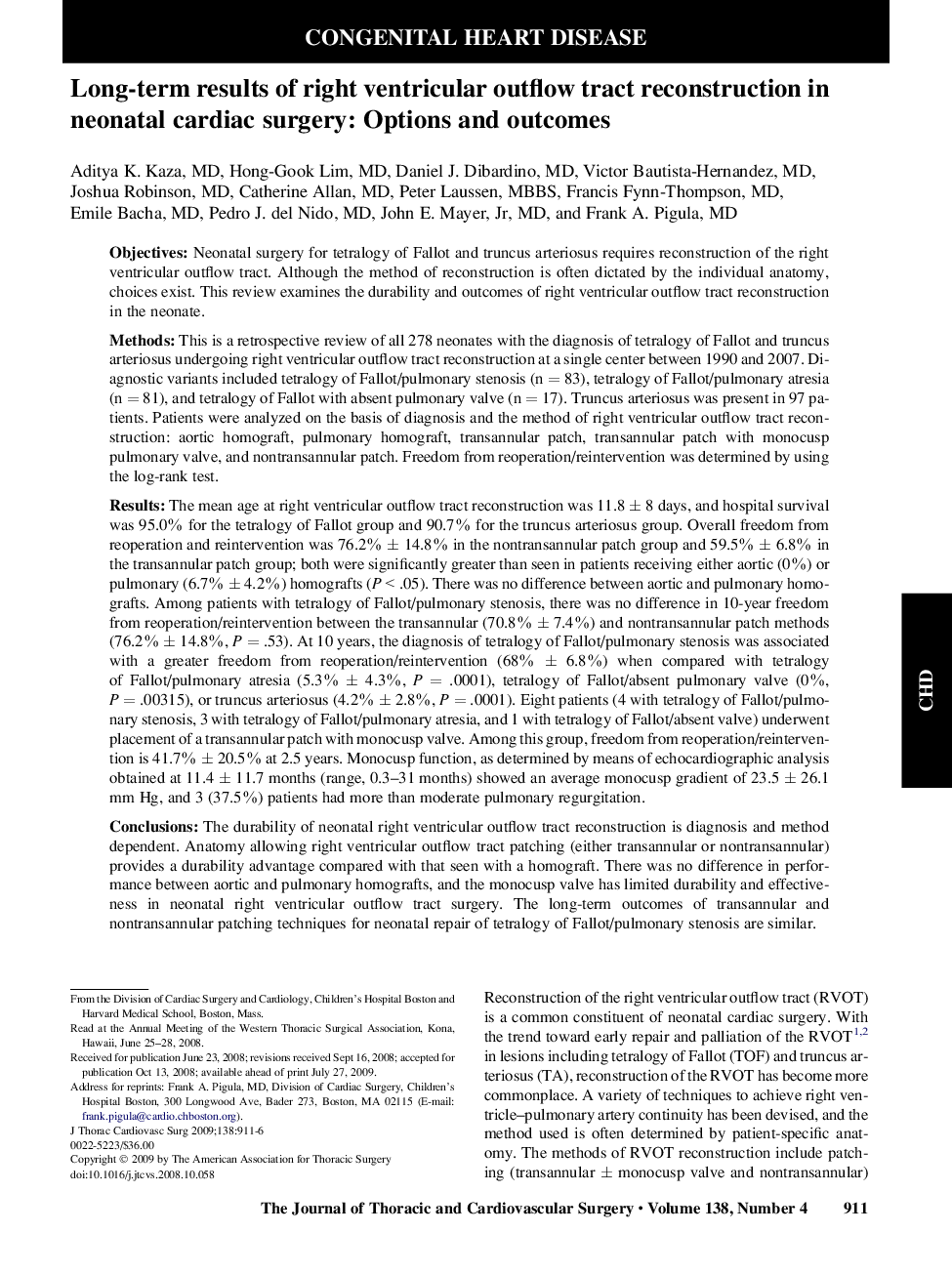| کد مقاله | کد نشریه | سال انتشار | مقاله انگلیسی | نسخه تمام متن |
|---|---|---|---|---|
| 2982091 | 1578669 | 2009 | 6 صفحه PDF | دانلود رایگان |

ObjectivesNeonatal surgery for tetralogy of Fallot and truncus arteriosus requires reconstruction of the right ventricular outflow tract. Although the method of reconstruction is often dictated by the individual anatomy, choices exist. This review examines the durability and outcomes of right ventricular outflow tract reconstruction in the neonate.MethodsThis is a retrospective review of all 278 neonates with the diagnosis of tetralogy of Fallot and truncus arteriosus undergoing right ventricular outflow tract reconstruction at a single center between 1990 and 2007. Diagnostic variants included tetralogy of Fallot/pulmonary stenosis (n = 83), tetralogy of Fallot/pulmonary atresia (n = 81), and tetralogy of Fallot with absent pulmonary valve (n = 17). Truncus arteriosus was present in 97 patients. Patients were analyzed on the basis of diagnosis and the method of right ventricular outflow tract reconstruction: aortic homograft, pulmonary homograft, transannular patch, transannular patch with monocusp pulmonary valve, and nontransannular patch. Freedom from reoperation/reintervention was determined by using the log-rank test.ResultsThe mean age at right ventricular outflow tract reconstruction was 11.8 ± 8 days, and hospital survival was 95.0% for the tetralogy of Fallot group and 90.7% for the truncus arteriosus group. Overall freedom from reoperation and reintervention was 76.2% ± 14.8% in the nontransannular patch group and 59.5% ± 6.8% in the transannular patch group; both were significantly greater than seen in patients receiving either aortic (0%) or pulmonary (6.7% ± 4.2%) homografts (P < .05). There was no difference between aortic and pulmonary homografts. Among patients with tetralogy of Fallot/pulmonary stenosis, there was no difference in 10-year freedom from reoperation/reintervention between the transannular (70.8% ± 7.4%) and nontransannular patch methods (76.2% ± 14.8%, P = .53). At 10 years, the diagnosis of tetralogy of Fallot/pulmonary stenosis was associated with a greater freedom from reoperation/reintervention (68% ± 6.8%) when compared with tetralogy of Fallot/pulmonary atresia (5.3% ± 4.3%, P = .0001), tetralogy of Fallot/absent pulmonary valve (0%, P = .00315), or truncus arteriosus (4.2% ± 2.8%, P = .0001). Eight patients (4 with tetralogy of Fallot/pulmonary stenosis, 3 with tetralogy of Fallot/pulmonary atresia, and 1 with tetralogy of Fallot/absent valve) underwent placement of a transannular patch with monocusp valve. Among this group, freedom from reoperation/reintervention is 41.7% ± 20.5% at 2.5 years. Monocusp function, as determined by means of echocardiographic analysis obtained at 11.4 ± 11.7 months (range, 0.3–31 months) showed an average monocusp gradient of 23.5 ± 26.1 mm Hg, and 3 (37.5%) patients had more than moderate pulmonary regurgitation.ConclusionsThe durability of neonatal right ventricular outflow tract reconstruction is diagnosis and method dependent. Anatomy allowing right ventricular outflow tract patching (either transannular or nontransannular) provides a durability advantage compared with that seen with a homograft. There was no difference in performance between aortic and pulmonary homografts, and the monocusp valve has limited durability and effectiveness in neonatal right ventricular outflow tract surgery. The long-term outcomes of transannular and nontransannular patching techniques for neonatal repair of tetralogy of Fallot/pulmonary stenosis are similar.
Journal: The Journal of Thoracic and Cardiovascular Surgery - Volume 138, Issue 4, October 2009, Pages 911–916